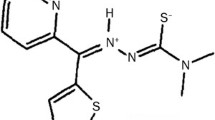Abstract.
Purpose: The present study was undertaken to look for an agent or agents able to modulate the cytotoxic effect of 5-fluorouracil (FUra) and to investigate the role of serine-threonine phosphatase inhibitors on the cytotoxic effect of FUra. Methods: The cytotoxicities of FUra and protein phosphatase inhibitors (PPIs) were evaluated by two different methods: a clonogenic assay and a proliferation assay. In the clonogenic assay, cancer cells were treated with various concentration of FUra with or without PPIs for 72 h. The drug-containing medium was replaced by fresh medium, the cultures incubated for an additional 10 days, and the colonies enumerated. In the proliferation assay the cells were treated with FUra alone or in combination with PPIs for 96 h and cytotoxicity was determined by the 3-(4,5-dimethylthiazol-2-yl)-2,5-diphenyltetrazolium bromide (MTT) assay based on the uptake of the tetrazolium dye. Thymidine kinase (TK) activity was determined based on the catalytic phosphorylation of [3H]d-thymidine to [3H]dTMP. Incorporation of FUra into DNA and RNA was determined by treating the cells with [2-14C]fluorouracil for 72 h and measuring the radioactivity in the isolated DNA and RNA fractions. Results: The serine-threonine phosphatase inhibitors caliculin A (CAL), okadaic acid (OA) and microcystin-LR (MCLR) dose-dependently inhibited the growth of Clone 20 and Clone 5 cells of Colon 26 murine colon adenocarcinoma cells, human cervical cancer HeLa cells, human gastric cancer MKN 7 cells, and murine sarcoma S-180 cells in vitro. Among the compounds tested, MCLR at non-toxic concentrations was found to increase FUra incorporation into RNA and DNA in Clone 20 cells by 60% and 127%, respectively, to increase TK activity alone (twofold) as well as in combination with FUra (threefold), and to potentiate the cytotoxicity of FUra synergistically and cytospecifically in vitro. The cytotoxicity of FUra alone or in combination with MCLR, but not that of PPIs alone, was abrogated almost completely by exogenous thymidine (dThd), suggesting that inhibition of thymidylate synthetase (TS) is the growth-limiting event in the cytotoxic action of FUra even in combination with MCLR. Conclusions: The findings presented here suggest that MCLR synergistically and cytospecifically potentiates the antitumor activity of FUra with substantial improvement in the therapeutic index of FUra via enhancement of both DNA- and RNA-directed cytotoxicity.
Similar content being viewed by others
Author information
Authors and Affiliations
Additional information
Electronic Publication
Rights and permissions
About this article
Cite this article
Islam, M., Begum, S., Lin, L. et al. Synergistic cytotoxic effect between serine-threonine phosphatase inhibitors and 5-fluorouracil: a novel concept for modulation of cytotoxic effect. Cancer Chemother Pharmacol 49, 111–118 (2002). https://doi.org/10.1007/s00280-001-0397-z
Received:
Accepted:
Published:
Issue Date:
DOI: https://doi.org/10.1007/s00280-001-0397-z




